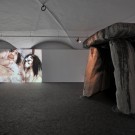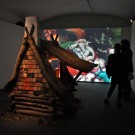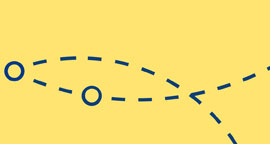Centre for Contemporary Culture at Palazzo Strozzi
Palazzo Strozzi
Nathalie Djurberg

Once Removed on My Mother’s Side, 2008
Clay animation, video, 6’00’’
Sound by Hans Berg
Fondazione Prada, Milano
Photo courtesy l’artista e / the artist and Fondazione Prada, Milano
Warning: A non-numeric value encountered in /var/www/vhosts/strozzina.org/httpdocs/admin/wp-content/plugins/lightbox-gallery/lightbox-gallery.php on line 443
- Nathalie Djurberg
Once Removed on My Mother’s Side, 2008 Clay animation, video, 6’00’’ Sound by Hans Berg Courtesy l’artista e / the artist and Fondazione Prada, Milano
- Nathalie Djurberg
Once Removed on My Mother’s Side, 2008 Clay animation, video, 6’00’’ Sound by Hans Berg Courtesy l’artista e / the artist and Fondazione Prada, Milano
- Nathalie Djurberg
Turn into Me, 2008 Clay animation, video, 7’10’’ Musica di / Music by Hans Berg Courtesy l’artista e / the artist and Fondazione Prada, Milano
- Nathalie Djurberg
Turn into Me, 2008 Clay animation, video, 7’10’’ Musica di / Music by Hans Berg Courtesy l’artista e / the artist and Fondazione Prada, Milano
- Exhibition view "Francis Bacon and the Existential Condition in Contemporary Art"
CCC Strozzina, Firenze © photo Martino Margheri
- Exhibition view "Francis Bacon and the Existential Condition in Contemporary Art"
CCC Strozzina, Firenze © photo Martino Margheri
- Exhibition view "Francis Bacon and the Existential Condition in Contemporary Art"
CCC Strozzina, Firenze © photo Martino Margheri
- Exhibition view "Francis Bacon and the Existential Condition in Contemporary Art"
CCC Strozzina, Firenze © photo Martino Margheri
- Exhibition view "Francis Bacon and the Existential Condition in Contemporary Art"
CCC Strozzina, Firenze © photo Martino Margheri
- Exhibition view "Francis Bacon and the Existential Condition in Contemporary Art"
CCC Strozzina, Firenze © photo Martino Margheri
- Exhibition view "Francis Bacon and the Existential Condition in Contemporary Art"
CCC Strozzina, Firenze © photo Martino Margheri
- Exhibition view "Francis Bacon and the Existential Condition in Contemporary Art"
CCC Strozzina, Firenze © photo Martino Margheri
- Exhibition view "Francis Bacon and the Existential Condition in Contemporary Art"
CCC Strozzina, Firenze © photo Martino Margheri
- Exhibition view "Francis Bacon and the Existential Condition in Contemporary Art"
CCC Strozzina, Firenze © photo Martino Margheri
- Nathalie Djurberg
Exhibition view "Francis Bacon and the Existential Condition in Contemporary Art" CCC Strozzina, Firenze © photo Martino Margheri
- Nathalie Djurberg
Exhibition view "Francis Bacon and the Existential Condition in Contemporary Art" CCC Strozzina, Firenze © photo Martino Margheri
- Nathalie Djurberg
Exhibition view "Francis Bacon and the Existential Condition in Contemporary Art" CCC Strozzina, Firenze © photo Martino Margheri
Nathalie Djurberg is a storyteller. To tell her stories, she makes films using a technique known as “stop-motion” in which the figures, mostly made of plasticine, are given a pose, photographed and then moved ever so slightly for the next photo so as to achieve the ultimate effect of movement on video. Her work reveals the intensity of her bond with tangible matter in a form of manual labour that demands long periods of work in solitude in her studio, while once on video the story takes on a new dimension in time, revealing its strong narrative content. Each one of the artist’s films is built following the internal dynamic of her own feelings and ends when she loses interest in the story or when the matter she is working with starts to fall apart, coming to the natural end of its useful life after being manhandled and kneaded countless times over.
Once Removed on My Mother’s Side is a story built around the slender, fragile figure of a daughter looking after her mother, who ends up crushing her with her overblown corpulence. The artist explores the darker side of human relationships, using her seemingly naive and childlike style to create a cruel and violent fantasy world, facing desires, unconscious fears and social taboos that usually remain hidden inside our inner worlds. The human body is represented in caricatural distortion, including in its most explicit sexual connotations and in mutilations that highlight its vulnerability and its transience. The disturbing sensation that permeates her films is underscored by the soundtrack created by Hans Berg, with whom the artist collaborates in an exclusive relationship based on mutual trust and interaction.
First shown in the “Turn into Me” exhibition at the Fondazione Prada in Milan in 2008, Of Course I am Working With Magic is an example of a new phase in her career, in which she began to produce video as well as installations. In this work the visitor finds him or herself observing an animated graphic in which he or she witnesses the distortion and disintegration of the female body. Anthropomorphic nature comes alive and aggresses the seemingly defenceless protagonist, who in her turn is transformed into a self-destructive monster visiting violence on her own body. The primitive aspect of the structure, reminiscent of some kind of archaic construction, acts as a sounding board for the film Jag sysslar givetvis med trolleri (the Swedish translation of the installation’s original title), in which the artist’s choice of small video format works as an analogy for the narrowness of the space in which she seems to want to confront the observer with her own interior visions.
Das Waldhäuschen (Small Hut in the Forest) is a difficult and somewhat surprising installation for the observer. Its tiny, child-size dimensions force the adult to make a physical effort to enter the hut and sit on a small chair in order to watch a video called Turn into Me. The film unfolds like a panorama through a window giving onto the outside world, thus contrasting the personal cosiness of the hut with the natural, wild world. A woman dies in a forest and her naked body starts to decompose as it is eaten away by worms that consume her flesh and her internal organs, causing the body to lose its shape and exposing its innards, which are transformed into organic matter, into humus that the earth reabsorbs. In an advanced stage of the decaying process, a raccoon and a mole appear and their energy breathes new life into the figure. The film and its structure evoke a fairy-tale world of children’s stories with their tiny enchanted houses and their magical forests inhabited by figures at once idyllic yet also threatening, which are often used as references in psychoanalysis. In this video Djurberg addresses the taboo subject of death, creating an allegorical fable on the cyclical nature of life. She prompts us to reflect on nature’s life-giving yet at the same time disturbing energy, using a depiction of the crude decaying process and the almost magical rebirth of a body as an image of nature’s ineluctable power.
BIOGRAPHY
Nathalie Djurberg (1978, Lysekil, Sweden; lives and works in Berlin), winner of the Leone d’argento at the Venice Biennale in 2009 as best young artist, carried out her artistic studies at the Malmö Art Academy and the Hovedskous Art School in Göteborg. Intolerant with more traditional artistic research and techniques, after making experimental videos with the Super 8 she received from her grandfather, Djurberg began to experiment with a particular type of video created with a technique known as claymation in which, through the stop motion method, she builds up stories and images whose protagonists are clay marionettes. Djurberg’s videos are always accompanied by musical backgrounds, composed by Hans Berg, which often act also as an estranging element that contrasts with the visual narration. Her first monographic exhibition dates from 2002 at Konstföreningen AURA in Lund, Sweden. In 2004 she presented Tiger Licking Girl’s Butt at Färgfabriken in Stockholm, while the first solo show at the Galleria Giò Marconi in Milan was realized in 2005. Her first monographic exhibition at the Zach Feuer Gallery in New York took place in 2006, and in 2007 Denn es ist Schön zu Leben was shown at the Project Space of Vienna Kunsthalle. In 2008 she was the central figure of Turn into Me at the Fondazione Prada in Milan, and other solo-shows were held at the Hammer Museum in Los Angeles and at the Santa Barbara Contemporary Arts Forum. Prospectif Cinéma, staged at the Centre Pompidou in Paris, and the exhibition Snakes Know It’s Yoga, set up at the Galleria Giò Marconi and at the Kestnergesellschaft of Hannover, took both place in 2009. The Parade at the Walker Art Center in Minneapolis and A World of Glass at the Camden Arts Centre in London date from 2011, while in 2012 solo shows were held at the Röda Sten Art Centre in Göteborg and at the Zach Feuer Gallery. Recent collective shows include: (2002) Nordic Hell, Gallery Konstakuten, Stockholm; (2004) Multiple Horizons, Museo d’Arte Contemporanea (MACRO), Rome; (2005) Enclosed. Contemporary Media Art Screening, British Museum, London; (2006) Into Me/Out of Me, MACRO, Rome; (2007) Family Pictures, Guggenheim Museum, New York; Pain/Schmerz hinter dem Knochen wird gezählt, Hamburger Bahnhof – Museum für Gegenwart, Berlin; The Shapes of Space, Guggenheim Museum, New York; (2008) Things You Never Saw, Terme di Diocleziano, Rome; After Nature, The New Museum of Contemporary Art, New York; Worlds on Video, CCC Strozzina, Firenze; (2009) Fare Mondi / Making Worlds, Palazzo delle Esposizioni, LIII Venice Biennale; La poupée de cire, la poupée de son, Migros Museum, Zurich; (2010) Ibrido. Genetica delle forme d’arte, Padiglione d’Arte Contemporanea (PAC), Milan; (2011) Anonymous Sculpture, Galerie im Taxispalais, Innsbruck; (2012) Gaze & Lust. Sexuality in Contemporary Art, Bergen Kunstmuseum, Bergen.























